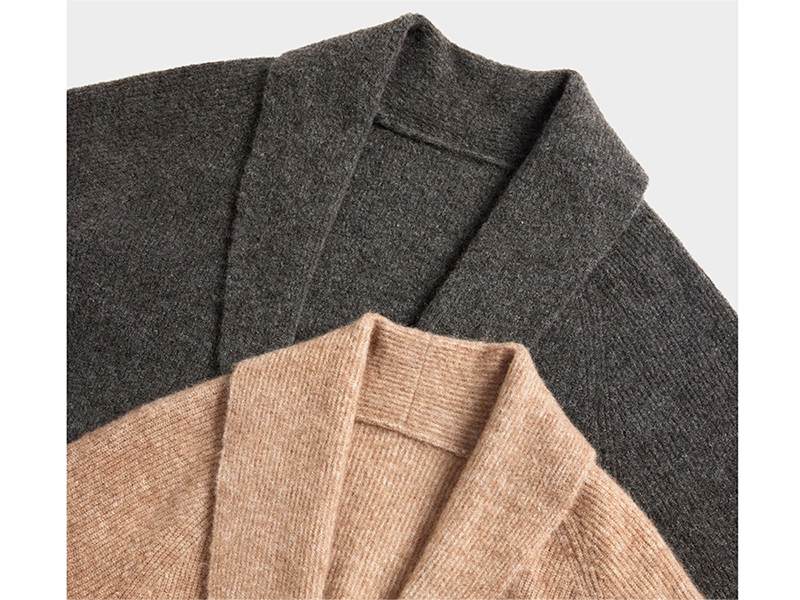Different sources
Wool, produced by sheep. Sheep produce wool, sheep do not produce cashmere! The best wool in the world comes from Australia, and Merino wool is recognized as the best wool in the world of wool.
Cashmere, produced by goats, comes from a thin layer of down closest to the base of the skin. Goats will grow fine fleece to keep warm in cold climates according to the temperature The best cashmere in the world comes from the Inner Mongolia region of China.
Collected in different ways
Wool is removed with scissors, each sheep produces a few kilograms of wool per year, collected with shears all shaved on.
Cashmere with tools to comb, cashmere grows in the coarse hair of the goat root cell phone to use a special comb bit by bit to count down, each sheep can only produce dozens of grams.
Warmth is different: cashmere > wool
Cashmere is wool 8 times, the same coverage area, the finer cashmere than wool surface area is greater than the static air between the cashmere can be stagnant more, so there is a better warmth, the degree of warmth of cashmere is 8 times the wool, and lighter than wool, the weight only accounted for the wool of the 1/5, one of the winter essential items.
Skin-friendly: cashmere > wool
Wool diameter 19~25 um
Cashmere diameter 14~16 um
Cashmere fiber consists of scales and cortical layer, does not contain the medullary layer, the average diameter of most of the 14~16 um.
The average diameter of cashmere fiber is 14~16 um, while the average diameter of wool is 19.1~25 um, even for fine wool.
Even for fine wool, the average diameter is 19.1~25 um, and the scale surface of fine wool is rough and not smooth.
Moisture absorption: cashmere > wool
Wool does not lose color after dyeing, full color, breathable and comfortable on the body.
The water absorption of cashmere sweater is the strongest among textile fibers, and the moisture return rate is more than 15%. If cashmere sweater is immersed in water, it will be wet into a ball in a few seconds, while wool sweater needs more than half a minute to be wet.
Shrinkage resistance: cashmere > wool
Cashmere sweater does not shrink after washing. Cashmere fiber curl number, curl rate curl recovery rate are larger, so the cashmere sweater has good restoration characteristics especially in the washing does not shrink, good shape retention and so on.
Wool sweater has shrinkage phenomenon. Shrinkage of wool fabrics is generally known as “felting”, the key factor in this phenomenon is “force”, as well as the special structure of wool. In short, if you wash at high temperatures and rub violently, shrinkage will occur.
Differences in wearability: Cashmere < Wool
Wool is more durable than cashmere. Wool does not lose its shape and elasticity quickly, even after a long period of wearing and washing.
In contrast: cashmere sweaters are more prone to deformation and pilling than wool sweaters, and if you don’t take care of them, they will become unwearable. But both need to pay attention to the way of washing oh ~ according to the clothes of the wash label to determine the way of washing.
Price difference: cashmere > wool
The price of pure cashmere is about 700 yuan / kg or more, while the price of wool is not more than 60 yuan / kg, the price difference of about ten times. Even the extra fine mercerized wool is not more than 90 yuan / kg, there are processing costs price is about 1.3 yuan / gram. The above is only the cost price oh. Of course, the industry in order to higher cost-effective, there are wool and cashmere blended, or blended with other fibers, need to pay attention to see the details of the fabric.
Cashmere wool washing guide
- dry cleaning or gentle hand washing is recommended, machine washing is prohibited (except after the shrinkage treatment of Australia’s 100% merino wool can be machine washed)
- Do not wash frequently, the water temperature is required to be below 30°C, high water temperature will lead to fabric shrinkage.
- It is recommended to use special detergent for wool and cashmere, do not use washing powder or soap and other alkaline washing products.
- We suggest that after washing, patting or pressing, do not vigorously rub or twist twist, you can use a towel rolled up and pressed to absorb water.
- Do not hang hangers for drying, can use the drying net to lay flat for drying. Do not expose to sunlight, drying, avoid direct sunlight and other heat sources.
- Do not wear with coarse products frequent friction, will increase the pilling phenomenon of woolen products.




 English
English Deutsch
Deutsch Français
Français Italiano
Italiano Español
Español Русский
Русский Polski
Polski Nederlands
Nederlands Svenska
Svenska

